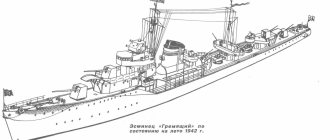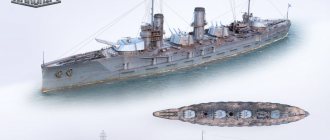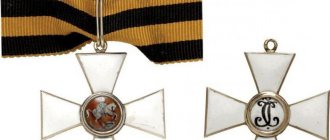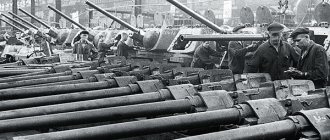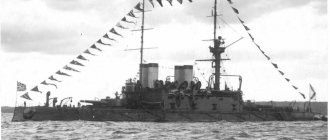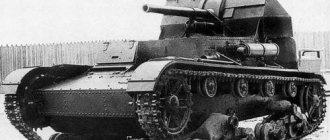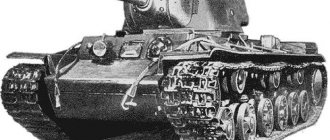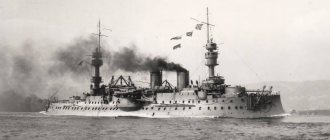Description of design
Frame
Diagram of the Poltava-class Battleship The
Poltava-class ships had a smooth-deck hull with a straight stem and a rounded stern, which was distinguished by a very unusual feature: a large slope inside the sides above the main deck in the bow and stern of the medium-caliber towers, especially clearly visible on the cross sections of the battleships. This design helped reduce the upper weight, which partly compensated for the high location of the guns in heavy turret installations, and most importantly, if not eliminated, then greatly reduced the destructive effect of powder gases on the upper deck from medium-caliber guns when they fired along the center plane. The hull had three full decks: lower, main (battery) and upper. The ram, located completely under water, protruded forward from the stem by 2 m. The side keels ran approximately from the center of the bow tower to the center of the stern one.
The spacing in the middle part of the ship (along the length of the armored belt - between frames 20 and 80) was 1.22 m, at the ends - 0.92 m. On frames 5, 9, 14, 20, 32, 48, 60, 70, 80 and 85 had transverse bulkheads that reached the lower deck. In the engine and boiler rooms there was a longitudinal bulkhead in the center plane, as well as two side ones, and in the engine rooms the side bulkheads were closer to the sides than in the boiler rooms. The main coal pits were located between the outer skin and the side bulkheads.
Booking
Information on the armor of Poltava-class battleships is very contradictory and incomplete. Initially, the ships were supposed to be protected with steel-iron armor; soon all-steel armor appeared, which began to be alloyed with chromium or nickel additives. After a little time, they came up with the idea of hardening steel using the Harvey method and, ultimately, the Krupp method. These changes, which occurred over literally several years, were taken into account by the Poltava ships, which is why the armor of the ships of this series varied in both thickness and quality, and absolutely reliable information on their armor protection was not found in the open press.
On the Sevastopol, in all likelihood, steel-nickel armor was used, with the exception of the middle section of the main belt: for it, 550 tons of Harvey steel were purchased in the USA. In Russian documents of that time, this enterprise is usually called the Bethlehem Plant, since the name of the biblical Bethlehem in English is written as Bethlehem
, which is the name of the American city where the said steel mill was located.
Main armor belt
"Sevastopol" had a length of 73.15 m and a height of 2.29 m, with a normal draft going under water by 1.39 m. Its middle part was 46.2 m long (between frames 32 and 70) at a height of 1.23 m from the upper edge had a thickness of 368 mm, and below it smoothly thinned to 184 mm (it seems to have been made from Harvey’s armor).
The rest of the belt had a thickness of 254 mm, also thinning towards the lower edge to 127 mm. At the ends, the main belt was closed by armored traverses
with a thickness of 229 mm at the bow and 203 mm at the stern.
On November 23, 1895, at the Okhtinsky training ground, a 368-mm slab of Harvey steel from a batch intended for installation on the Sevastopol was subjected to test firing and a 229-mm 30-caliber gun (projectile weight 178-179 kg, speed when hitting the slab up to 588 m/s). None of the shots penetrated the slab. Calculations have shown that the resistance of this armor plate is equivalent to a 635 mm iron armor plate.
The upper belt ran above the main one
127 mm thick, 2.29 m high and about 50 m long. At the ends it was closed by bulkheads of the same thickness inclined to the center plane, reaching the barbettes of the main caliber towers. There were doors on each side of these bulkheads.
Armor deck
, passing along the upper edge of the main belt, had a thickness of 51 mm. At the ends that did not have side armor, it dropped below the waterline and took on a carapace shape, having a thickness of 63.5 mm in the horizontal part and 76 mm at the bevels.
The main caliber towers and their barbettes had a thickness of 254 mm. The roofs of these towers were 51 mm thick.
The medium-caliber towers and their barbettes had a thickness of 127 mm, their roofs - 25 mm.
Battery
The 152 mm guns had no protection other than the side plating. However, with the beginning of the war, the sheathing was reinforced with iron sheets with a total thickness of 76 mm.
Conning tower
protected by 229 mm armor.
The main differences between the Poltava-class ships were their armor, and absolutely reliable information on this matter did not appear in the open press. Armadillos were built during the rapid progress of metallurgy, when literally in a few years steel-iron armor was replaced by steel (in particular, by the widely used steel-nickel), a little later - by steel hardened according to the Harvey method, and a little later - according to the Krupp method . They tried to take these achievements into account on the Russian ships under construction, but they succeeded to varying degrees.
"Petropavlovsk" had a reservation scheme typical for battleships of that period, the basis of which was the main armor belt along the waterline with a length of 73.15 m (65% of the hull length) and a height of 2.29 m (of which, at normal draft, 1.39 m was under water ). The main armor belt protected the vehicles, boilers and bases of the gun turrets. In the central part for 46.2 m (between frames 32 and 70), its thickness was 406 mm, and further forward and aft (to frames 20 and 80), in the area of the main caliber towers, the thickness of the armor plates decreased to 305 mm. Toward the lower edge of the slabs, their thickness was halved, to 203 mm in the central part and to 152 mm closer to the ends. From the bow, the belt was covered with an armored traverse 229 mm thick, from the stern - 203 mm thick.
Above the main armor belt there was an upper armor belt about 50 m long, 2.29 m high and 127 mm thick, resting on the barbettes of the main caliber turrets.
From above, the main belt was covered with a flat armored deck 51 mm thick; outside the armor belt, the armored deck became vaulted (carapace) with a thickness of 63.5 mm in the flat part and 76 mm on the slopes.
The main caliber turrets and barbettes were protected by 254 mm thick armor; the turret roofs were 51 mm thick. Medium-caliber turrets and barbettes had armor thickness of 127 mm, roofs - 25 mm.
The four 152-mm guns located in the battery had no protection other than the side plating. However, with the outbreak of the Russo-Japanese War, the entire side between the medium-caliber towers between the main and upper decks was protected by half-inch iron sheets with a total thickness of 76 mm.
The conning tower was protected by 229 mm of armor.
The quality of the armor varied in different areas. Most of the vertical armor was made of steel-nickel armor manufactured at the Izhora plant. The armor deck was made of soft nickel steel. The central part of the belt, 406 mm thick, was used for Harvey armor specially purchased in the USA (a total of 605 tons were purchased at 485.55 rubles per ton). True, not everything is clear with the latter. The fact is that on July 1, 1895, at the Okhta test site, they tested a 406-mm armor plate from a batch intended for Petropavlovsk, but this plate was steel-nickel, and not hardened using the Harvey method. It was penetrated by the third shot from a 229-mm gun with a barrel length of 30 calibers (the projectile speed at impact was 531 m/s, its weight was 179 kg). Calculations have shown that the tested armor plate is equivalent in resistance to 546 mm iron armor. At the same time, the 368-mm plate for Sevastopol, which was indeed Harvey's, was never penetrated during testing, and its resistance was estimated at 635 mm of iron. Thus, it remains unclear whether the central section of the Petropavlovsk belt was made of Harvey armor and, if so, what part of it.
The battleships did not have structural anti-torpedo and anti-mine protection, with the exception of coal bunkers located at the sides and a double bottom.
Artillery weapons
Main caliber
The Poltava-class battleship was quite traditional and consisted of four 305-mm guns with a barrel length of 40 calibers, located in two turrets at the bow and stern of the ship. Along with the battleships “Three Saints” and “Sisoy the Great” they received guns of this system (previously 35- and 30-caliber guns were used). The guns were manufactured by the Obukhov plant, and the turrets were ordered by the Metal plant.
According to the original design, the armor protection of each main-caliber turret weighed 446 tons, but after changing the design, the weight of the armor, including the lining, was reduced to 316-328 tons (the entire turret without guns weighed 496 tons). As it later turned out, the design was not strong enough and had to be reinforced, which ultimately negated the weight savings achieved, but even then, firing full charges from both guns at once in peacetime was allowed only in extreme cases.
The aiming and loading drives were hydraulic, and the ammunition supply was electric. The horizontal guidance angle was 270°, the gun elevation angle was from −5° to 15°, and the horizontal guidance speed was up to 2.2 degrees/s. Loading was carried out at any horizontal guidance angle, but at a fixed vertical one. The contract rate of fire was one shot per minute and a half, however, due to the unsuccessful design of the lock, coupled with the requirement to ensure that one person could load and fire the shot, the actual rate of fire was significantly lower: an unaimed shot took 2-2.5 minutes (of which opening and closing the lock with a hydraulic the drive took 14 seconds each) this was a consequence of the use of the Rosenberg system on Russian large-caliber guns, which took a lot of time to open and close the shutter, while the Velin shutter performed the same operations in 5-7 seconds. Each 305 mm gun contained 58 rounds of ammunition.
As a medium caliber
Initially, it was planned to install eight 203-mm 35-caliber guns in four barbettes, but after the rapid-firing guns of the Kane system were adopted, it was decided to use them. Since the 152 mm 45-caliber Kane gun was more than half the weight of the old eight-inch gun, in addition to the turret guns, it was possible to place four more in an unarmored battery placed between the medium-caliber turrets. With the beginning of the Russo-Japanese War, these four guns were protected on the side by sheets of iron with a total thickness of 76 mm. The effectiveness of this protection, however, could not be verified: there was not a single hit in the battery during the war.
The medium caliber turrets were manufactured by the Obukhov plant and had a round turntable. The bow turrets had horizontal guidance angles from 0° to 135° on board, the stern ones - from 45° to 180°. Vertical guidance angles ranged from −5° to +15…18°. The towers had electric and manual drives for horizontal guidance; in the vertical plane, the guns were aimed only manually.
The guns in the battery were aimed manually; The guidance angle in the horizontal plane was 100° (50° forward and backward from the beam), vertical - from −5° to +15°.
The ammunition load of each gun included 200 rounds of separate cartridge loading.
Anti-mine battery
included twelve 47 mm and 28 37 mm single-barreled Hotchkiss guns. 47 mm were installed side by side on the spardeck (on the sides of the conning tower, bow pipe and mainmast), on the main deck in front of the main anchors and the aft balcony, and in the stern itself under the balcony. Ten 37-mm cannons were located on the combat top, six on the hanging bridge, four aft on the main deck and six aft on the lower deck. Two more 37-mm guns were intended to arm mine boats.
During the war, the lower deck guns were removed: they were too close to the water and practically could not be used. Some of them were moved to the aft balcony, spardeck and hanging bridge, and the rest went to the coastal positions of Port Arthur.
The ship's artillery armament traditionally included two 63.5 mm landing guns
Baranovsky, which could be installed on ship or wheeled carriages, and also fired from large boats.
Mine weapons
The ship had four 381-mm surface torpedo tubes and two 457-mm underwater torpedo tubes. Two 381-mm fixed devices stood without any protection at the ends of the ship, two more movable ones were located somewhat behind the mainmast and in front of the aft turret behind the 127-mm armor of the upper belt and had pointing angles from 35° forward to 45° aft . The 457-mm devices were installed motionless in front of the bow turret at an angle of 12° aft from the beam.
In addition to torpedoes, the ship had 50 spheroconic barrage mines stored in a mine cellar under the underwater torpedo tube compartment. Mines were laid from boats and boats connected into so-called “mine rafts”.
Mine steam boats (two units) could be armed with one mine launcher and one 37-mm cannon each.
Power plant
Two main steam engines
design power 10,600 l. With. (unfortunately for Sevastopol, the cars were ordered not in England, as happened with its sisterships, but at the St. Petersburg Franco-Russian plant). The machines were quite conventional triple expansion mechanisms and were powered by four-bladed propellers with a diameter of 4.5 m.
The ships were equipped with 16 cylindrical steam boilers in two boiler rooms. According to the design, the steam production of the boilers with natural draft was sufficient for a power of 9000 liters. pp., which ensured a speed of 16 knots; when using forced blast, the power increased to 10,600 hp. s., and the speed is up to 17 knots. "Poltava" became the last Russian battleships with cylindrical boilers, the rise of steam in which took several times longer than in the water-tube boilers that had already appeared.
Both chimneys had a smaller height than the ventilation mast located between them (the ratio of the heights of the chimneys and this mast was the main external difference between the Poltava-class battleships). On the Sevastopol they were round, while on the other two battleships of the Poltava type the second pipe was elliptical: the chimneys of six, not eight, boilers went into it (14 boilers were installed on these ships).
According to official data, during an additional three-hour run on July 11, 1900 (the main one, held on October 16, 1899, was interrupted due to a steering failure), with a displacement of 11,249 tons, the Sevastopol showed a power of 9,368 indicated hp. With. and average speed 16.41 knots. Underloaded "Poltava" (all artillery was missing, except for the main caliber guns) with a power of 11,255 ind. l. With. developed an average speed of 16.29 knots with a maximum of 16.5 knots, and “Petropavlovsk” with a displacement of 10,890 tons and a power of 11,213 ind. l. With. showed an average speed of 16.38 knots and a maximum of 16.86 knots. During seven-hour tests, Sevastopol developed only 15.3 knots.
Coal reserve
(700 tons normal and 1050 tons full; according to other sources, 900 and 1500 tons, respectively) according to the project was supposed to provide a 10-knot cruising range of 4500 miles. The actual cruising range turned out to be less: 10 knots with a reserve of 900 tons - 2800 miles, with a reserve of 1200 tons - 3750 miles; 15-knot speed with full reserve - 1750 miles.
Other ship systems
Electricity
produced five generators; four of them provided a current of 640 A each and one - 320 A.
Six combat searchlights with a diameter of 75 cm with angles of action of 180°-220° were placed in pairs on the saling of the foremast, and on the platforms of the mainmast and middle mast between the pipes.
In 1897, "Poltava" and "Sevastopol" became the first Russian ships to receive stationary radio stations
Popov-Ducretet systems with a range of up to 15 miles.
Set of boats
was standard for ships of the 1st rank: two steam mine [boats on the keel blocks of the upper deck between medium-caliber towers, two 20-oared longboats and two 16-oared boats on the spardeck, two 14-oared boats, two whaleboats (commander and worker) and two yala - these six boats hung on davits when moored in the roadstead, and during the voyage they were installed as a second tier on the spar deck. For lowering and lifting boats and longboats there were four cargo booms - two each on the main mast and the ventilation mast between the pipes.
Anchor device
included two main Admiralty anchors weighing about 6.5 tons, stored in the manner of ships of the sailing fleet, only the cradle and cat-beams became metal. It took about an hour to clean them. In an open area of the battery deck, two auxiliary anchors of the Martin system were stored under the ports of the 152 mm guns closest to the stern.
Crew
The ship consisted of 21-27 officers and 605-625 lower ranks.
Links[edit]
- Jump up
↑ McLaughlin 2003, pp. 84–85, 90. - Jump up
↑ McLaughlin 2003, pp. 84, 88–89. - Jump up
↑ McLaughlin 2003, pp. 84–85, 89–90. - Silverstone, page 382.
- Jump up
↑ McLaughlin 2003, pp. 84, 86, 90. - ^ a b McLaughlin 2008, p. 53.
- Jump up
↑ Westwood, pp. 15–21. - Jump up
↑ McLaughlin 2003, p. 160. - Forczyk, pp. 41-43.
- Forczyk, pp. 45-46.
- ^ a b c d e McLaughlin 2008, p. 54.
- ^ a b c McLaughlin 2003, p. 163.
- Watts, page 21.
- Forczyk, pp. 49-52.
- Wilmott, p. 90.
- Jump up
↑ McLaughlin 2003, p. 164. - "Effect of High Angle Fire on Russian Ships at Port Arthur". US Ordnance Magazine
.
26
: 138. 1906. - ^ abcdefg Lengerer, page 52.
- Silverstone, page 337.
- Jump up
↑ McLaughlin 2003, p. 451. - Lengerer, p. 50.
- Jentschura, Jung and Mikel, p. 19.
- ^ a b Taras, p. 24.
- Jump up
↑ McLaughlin 2008, pp. 54–55. - Jump up
↑ McLaughlin 2008, p. 55. - ^ a b c McLaughlin 2003, p. 91.
- Silverstone, page 374.
- Jump up
↑ McLaughlin 2008, pp. 55–56. - Jump up
↑ McLaughlin 2008, p. 56.
Homecoming
10 years later, France and England decided to launch the Dardanelles operation, the purpose of which was to capture one of the Black Sea straits. Russia wanted to fight back with the help of its squadron, but there were few ships left, so it was decided to buy back from the Japanese their own battleships, which were captured a decade ago. According to the agreement concluded with Japan, for 15.5 million rubles, Russian troops managed to buy and bring home three ships: “Tango”, “Soyu” (Russian “Varyag”) and “Sagami” (Russian “Peresvet”). They were delivered to Vladivostok in March 1916.
The purchased ships were returned to their original names, "Tango" was renamed "Chesma", since "Poltava" was the name of one of the new dreadnoughts. The new captain of the battleship V.N. Cherkasov wrote in his report that the ship was far from in ideal condition.
Beginning of the Russo-Japanese War
On the night of January 26, 1904, Japanese destroyers attacked a Russian squadron stationed near Port Arthur, which after the battle lost two large ships, but managed to drive away the enemy, who for some reason, in the midst of the battle, became embarrassed and began to retreat. "Poltava" in this battle, fragments from bombs hit the onboard torpedo tube, but something saved the crew and the ship from the explosion: only three crew members were wounded. The battleship itself managed to fire about seventy charges at enemy ships. In the morning, after the end of the battle, the Russian ships sailed into the inner harbor, during the entrance to which the Poltava and Sevastopol touched each other on their sides.
In mid-March, a steam boat was launched from the battleship Poltava, which launched a mine at the Japanese squadron and sank one of the fireships. Soon after this, the ship's crews began to dismantle the artillery and equip it with a four-gun battery on Quail Mountain to defend Port Arthur, which the Japanese were preparing to attack. On June 26, the Poltava was in Tahe Bay, from where, together with other battleships and cruisers, it fired at the Japanese squadron.
During the revolution
After the October Revolution, the crew of the Chesma sided with the Soviet regime, and in March the ship was captured by the British, who began to use the battleship as a floating prison. Two years later they abandoned the ship during the evacuation from Arkhangelsk. When it was found in June 1921, it was deposited in the Arkhangelsk port, and after three years of inactivity there, it was decided to send “Chesma” to the Stock Property Department in order to be dismantled for metal. The same was done with other squadron battleships of the Poltava type.
In besieged Port Arthur
At the end of autumn, the Japanese managed to capture the heights near Port Arthur and began shelling Russian ships from there. On November 22, the Poltava was hit by a shell that exploded in the cellar, causing the Poltava to begin to sink, eventually settling on the ground. The crew, which at that time consisted of 311 lower ranks and 16 officers, was captured by the Japanese.
In July 1905, the Japanese completed repairs to the captured battleship Poltava and, having raised it into the water, renamed it Tango. During the restoration, some masts, pipes, ventilation ducts and torpedo tubes were replaced. And four years later, Tango became a full-fledged Japanese coast guard battleship. Its crew was increased to 750 people.
Construction
The model of the battleship "Poltava" was planned based on the drawings of the battleship "Nicholas I", which had great impressive seaworthiness, but in "Poltava" it was planned to increase the displacement in order to thereby increase the cruising range. In addition, another turret with two guns, each 305 mm, was installed on the new battleship.
On May 7, 1892, in the presence of Alexander III and his family, the Poltava was laid down, although initial work on the ship, led by the famous naval engineers I.E. Leontyev and N.I. Yankovsky, began in February of the same year. Despite the subsequent rather lengthy construction, the battleship was launched on October 25, 1894.
Links[edit]
- Forczyk, Robert (2009). Russian battleship versus Japanese battleship, Yellow Sea 1904–05
. London: Osprey. ISBN 978-1-84603-330-8. - Jentschura, Hansgeorg; Jung, Dieter and Mikel, Peter (1977). Warships of the Imperial Japanese Navy, 1869–1945
. Annapolis, MD: United States Naval Institute. ISBN 0-87021-893-X. - Lengerer, Hans (September 2008). Ahlberg, Lars (ed.). "Tango (formerly Poltava)." Contributions to the History of Japanese Imperial Warships
(Document V): 50–52. (subscription required) (contact the editor at lars.ahlberg halmstad.mail.postnet.se for subscription information) - McLaughlin, Stephen (September 2008). Ahlberg, Lars (ed.). "Poltava". Contributions to the History of Japanese Imperial Warships
(Document V): 53–56. (subscription required) - McLaughlin, Stephen (2003). Russian and Soviet battleships
. Annapolis, MD: Naval Institute Press. ISBN 978-1-55750-481-4. - Silverstone, Paul H. (1984). Directory of the World's Capital Ships
. New York: Hippocrene Books. ISBN 0-88254-979-0. - Taras, Alexander (2000). Ships of the Russian Imperial Navy 1892-1917
[
Ships of the Imperial Russian Navy 1892-1917
]. Military-historical library. Minsk: Harvest. ISBN 978-985-433-888-0. - Watts, Anthony (1990). Imperial Russian Navy
. London: Arms and Armor Press. ISBN 978-0-85368-912-6. - Westwood, J. N. (1986). Russia vs. Japan, 1904–1905: The Russo-Japanese War Revisited
. Albany, NY: State University of New York. ISBN 0-88706-191-5. - Wilmott, Hadley (2009). The Last Century of Sea Power: From Port Arthur to Chanak, 1894–1922. Bloomington, IN: Indiana University Press. ISBN 978-0-253-35214-9.
